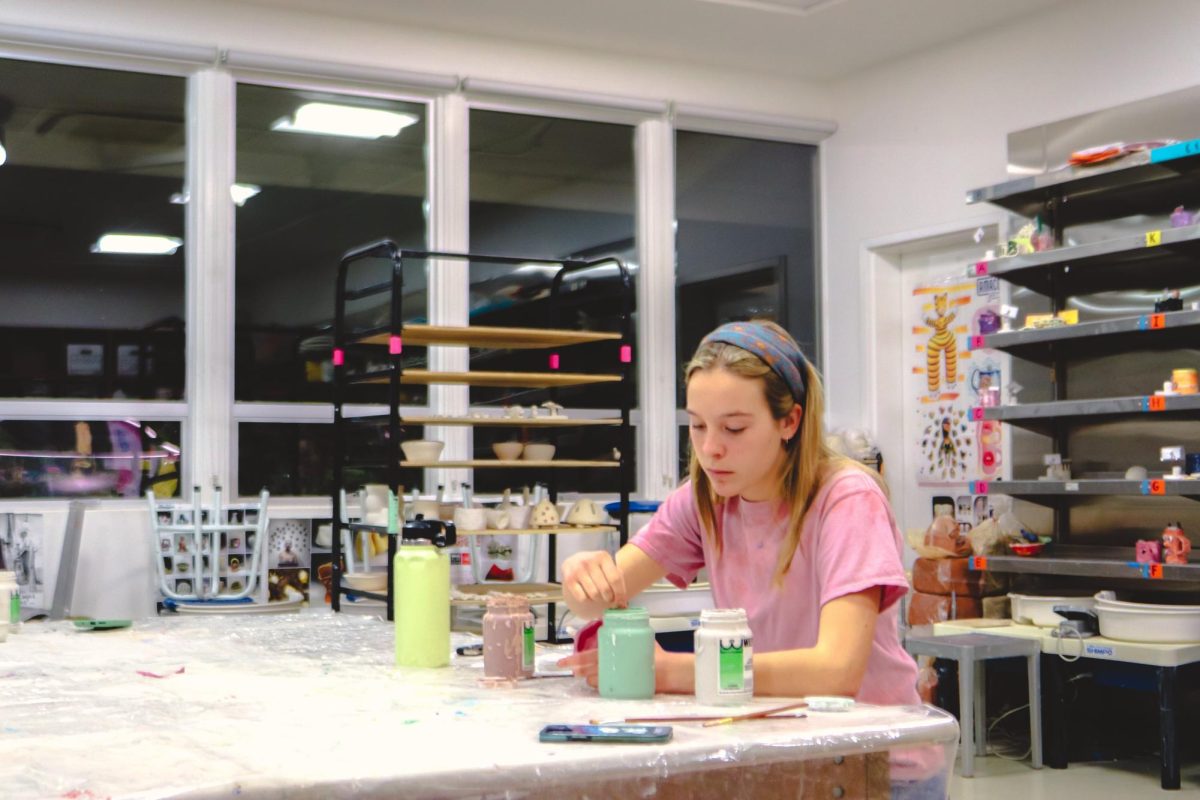Picture the conventional rock band. A seemingly confident male shredding the guitar, the classic gentleman on the bass, the angry man pounding his heart out on the drum set, maybe a mellow guy throwing in some keys, and a girl standing center stage, clutching the microphone tightly.
The illustrative descriptions given to the male members of the band may differ between musical groups, but the disproportionate ratio between men and women and the image of a female vocalist are not simply stereotypes. They are undeniable realities.
Women were almost entirely absent during the rock age, but the few women who managed to climb to fame found their footing exclusively as singers. Two of Paly’s female vocalists share their perspectives on the reasoning behind the disparity that began in the ‘60s and prevails in ways today, and how misconceptions associated with singing can affect a female vocalist’s self-worth.
Marina Buendia is the lead singer and the sole female member of an all-freshman band that has graced students with live performances twice this current school year. Having spent time working with rock music firsthand, she has come to recognize that women did not have a adequate role in the rock and roll scene, or proper acceptance.
According to Buendia, male musicians throughout the rock age may have encouraged women to participate on vocals to protect a sense of superior musical talent, leading women to find refuge as singers.
“Men feel threatened whenever a woman does something that’s supposed to be a male talent,” Buendia said. “They may not have accepted that women were just as capable of performing the rest of the instruments.”
She said people became accustomed to the male dominated rock industry, leading them to associate the genre of music with a hardcore, manly image, perhaps because of the noise and power that women stereotypically may be unable to handle.
“Society has made the drums, electric guitar, keys and bass into more male instruments,” Buendia said. “That leaves women as ‘just’ the singers and nothing more.”
Senior Emily Tomz found her way into a band comprised of four upperclassmen this year, assuming the role of the lead singer. However, her musical identity has been shaped by years on the piano along with recent interest in the acoustic guitar. She has found it difficult to embrace the role of singing wholeheartedly, making an analogy between a voice and one’s physical appearance, both qualities that people are born with.
“If someone tells you that you look pretty, you haven’t accomplished anything to earn that compliment,” Tomz said. “But if instead they tell you you’re really good at something, it’s because you’ve worked your way to that point, and that’s gratifying.”
Society’s subconscious bias towards singing can contribute to the artist feeling undeserving of credit for having a talented voice. While Tomz applies this theory to vocal talent, she does not reserve the same opinion towards instrumental talent.
“I used to perform in piano recitals, and I remember that when someone would compliment my ability to play piano, it felt gratifying, because they understand that I’ve put in a lot of work to get to the level that I am at,” Tomz said.
However, her experience as a piano player, singer and guitarist have allowed her to form a reasonable explanation that accounts for the disparity in audience perceptions of musicians.
“Everyone — even those who know nothing about music — recognizes that no one is just born knowing how to play an instrument. They realize that you have start from nothing to learn it and put a lot of time in, and for this reason they unintentionally have more respect for those who play instruments than those who sing.”
Emily Tomz
It is almost ironic that singers consistently feel less accomplished than the surrounding musicians, as the art of singing is a risk that challenges the artist on a more personal level.
“When you perform with your voice, you become more vulnerable to making mistakes,” Buendia said. “If you’re playing the guitar and it’s out of tune, you can blame on the guitar itself, but if you sing out of tune, it’s all on you.”
Singing is not a defining piece of Tomz’s musical identity, however Buendia’s voice is a larger part of herself, leading her to experience frustration when dealing with misconceptions about her craft. It is easy to construct the idea that some individuals are simply naturally gifted with a beautiful voice, unintentionally disregarding the time, effort and commitment dedicated to developing a voice in order to achieve control and technique.
“Training your voice is the same exact thing as practicing another instrument. I practice singing every day, just like a guitar player practices his guitar, and I believe that this effort should be acknowledged.”
Marina Buendia
Within subtle comments directed at herself and her bandmates, Buendia catches a glimpse how audiences evaluate her talent as against the abilities of her bandmates.
“People like to tell me, ‘Oh, you’re so good at singing,’” Buendia said. “But when they compliment our drummer, they elaborate more, trying understand how he got that good. The compliment is followed by questions like, ‘How many years have you been playing?’”
Rock and roll was dominated by male figures, and when contrasting the rock industry with today’s pop music scene, it appears that women have bridged the gap and have obtained equal representation. However, upon closer look, it becomes apparent that today’s famous female musicians are often publicized primarily for their physical features, shifting the focus away from the music itself.
“When women are performing, the producers want to give the male [audience] something to enjoy” Buendia said. “They’ll give the girls skimpy outfits in performances because they think the men won’t be able to focus on the music so much as the performer.”
She notes the difference in attire between male and female artists on social media sites, platforms that are a prevalent influence on younger generations.
“Someone like Shawn Mendes is always [photographed] with his guitar in casual jeans and really normal outfits, so no one’s attention is on his clothing,” Buendia said. “Everyone focuses on his songs, his voice and his lyrics. However, someone like Hailee Steinfeld’s performances have to be over the top; she has to be wearing really big outfits that people comment on, drawing the focus away from the music itself.”
There is an relatively equal distribution of male and female singers, however the number of women who choose to play instruments is low considering that there is nothing about an instrument that should be associated exclusively with male interest.
Everything, including this disparity, originates from the youngest generation, and children do not have enough representation of women on instruments to develop dreams about becoming one, Tomz said.
“Women aren’t known for playing instruments, and that’s what children will see,” Tomz said. “So a lot of little girls growing up are going to say to their parents, ‘I want to be a singer when I grow up.’”
An alternate case is one where the female vocalist plays an instrument in addition to singing, but the latter detail is overlooked.
“I love the band ‘Of Monsters and Men,’ and while the lead singer is a woman, she also plays some instruments,” Tomz said. “Most people don’t know that. Another example is that Taylor Swift sings, but she also plays the piano and the guitar, and somehow that’s not advertised as part of her musical talent.”
Achieving equal representation is certainly a first step, but the next will be reaching an industry where women dominate on both the microphone and the surrounding instruments. Tomz draws parallels between milestones that women have made in other industries in terms of leading change, something that she hopes will happen for the music industry.
“In order for women to step into the rock industry, and any industry at that, they must have more of a voice, be more assertive and be unafraid to speak their minds and say what they want,” Tomz said. “Throughout history women have grown to do so, so the music industry should be the next step.”
She has her own perspective on the matter through experience as the sole female member in her band, and fully understands that this is no simple task.
“Sometimes in my band, I wouldn’t mind playing the backup guitar, but it’s difficult to voice that,” Tomz said. “I find myself shying away from playing; I know that it is hard to take the first step.”
In addition to women taking steps to initiate change, their efforts have to be received and respectfully encouraged by men in the industry.
“It has to do with the men also acknowledging that women can play guitar, that they have the talent to play instruments, and that they can be more than ‘just the singers,’” Tomz said. “When we wrote a song together as a band, that was truly the most fun I’ve had because we were all working together and it put us on the same level, all working off of each others’ ideas as equals.”













